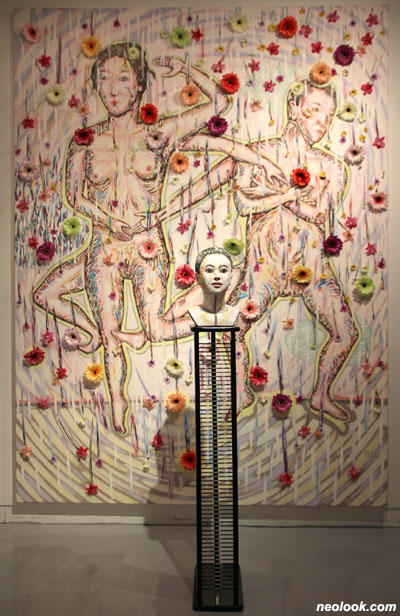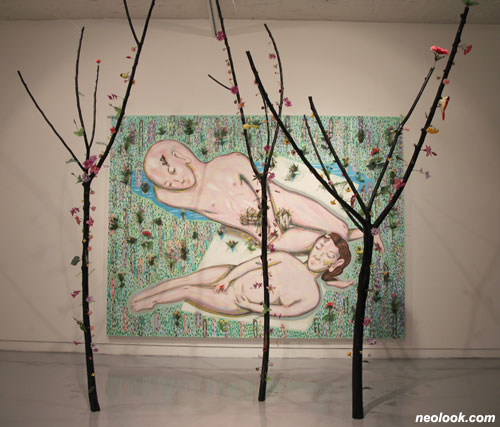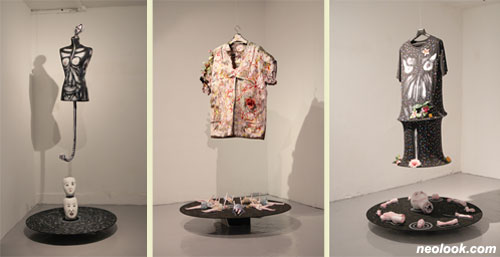- ● homepage
- ● archives
- ● restoration
- ● books
- ● big banners
- ● post board
- ■ neo's search
- ■ about us
- ■ 게재방법 안내
- 개인정보처리방침

- [email protected]
- Tel. 02_335_7922
- Fax. 02_335_7929
- 10:00am~04:30pm
- 월요일~금요일
- 3/3(월) 대체공휴일

존재의 비망록
정복수展 / JUNGBOCSU / 丁卜洙 / painting 2011_1102 ▶ 2011_1204 / 월요일 휴관

- 정복수_꽃이 떨어지는 시간_캔버스에 오브제, 유채_ 259.1×193.9×6.5cm_2008~11
초대일시 / 2011_1102_수요일_05:00pm
기획 / 사비나미술관 학예연구실
관람료 / 성인 2,000원 / 학생 1,000원
관람시간 / 10:00am~06:30pm / 월요일 휴관
사비나미술관 Savina Museum of Contemporary Art 서울 종로구 안국동 159번지 Tel. +82.2.736.4371 www.savinamuseum.com
존재의 비망록: 운명과 욕망의 주체사이 ● 정복수는 79년도 개인전에서부터 얼굴과 벌거벗은 인체에 내장을 그리는 「몸」에 관한 주제로 계속 작업해 오고 있다. 그는 아무것도 걸치지 않은 벌거벗은 육체에 내장을 그리고, 민머리의 단순한 얼굴에 눈, 코, 입, 귀를 입체적으로 꼴라주 한 것처럼 그린다. 캔버스 화면배경은 우주와 인간을 연결하는 운명처럼 공허하게 비워두고 그 안에 자신을 둘러싸고 있는 사회와 존재자체를 인체로 표현하며 때때로 언어를 삽입한다. 그래서 그의 그림은 안 보이는 부분을 드러낸 생체 해부학 도판이나 동양의학에 사용되는 경혈도를 연상하게 한다. 정복수는 탐욕과 배설의 인간사를 가장 솔직하게 드러낼 수 있는 것으로 아무것도 걸치지 않은 벌거벗은 육체라고 말하며 얼굴부위와 몸의 안과 밖 부분을 도구처럼 절단하고 조합하여 인간이야기들을 그려 낸다. 그의 작업에서 언어는 매우 중요하며 은유로 표현된 형상으로 부터 작품 제목을 구체적으로 제시함으로 그가 추구하는 예술적 사유와 표현의 이해를 돕는다. 그의 상징적이며 은유적 표현의 회화는 문자와 언어의 시지각과 함께 총체적 감각으로 소통된다. ● 이번 개인전에서는 2006년에서부터 2011년까지 제작된 유화, 조각, 설치작품들을 선보이는데 이전의 드로잉성향이 강한 작업과는 달리 다양한 질료와 화려한 색채가 특징이다. 인조 꽃, 인형, 마스크 등의 오브제들이 회화의 화면에 마티에르로서 사용되고, 자유로운 터치와 밝은 색채가 시대적 인간형상으로 소통될 수 있도록 하고 있다. ●「내장의 추억 2010년작」은 몸의 내장으로부터 외부소통과의 관계를 보여주며 예전 작업과 연결고리를 갖는다. 벌거벗은 중년남성은 튀어나온 배를 중심으로 얼굴을 위로 하고 구불구불한 곡선의 내장들을 내 보이며 화면 중앙에 서 있다. 외부로부터 타인의 시선(눈)이 그려진 뱀 같은 관은 남자의 가슴(심장)으로 파고 들어가 내장에 영향을 미치고, 가장 굵은 소화기내장과 연결된 혀끝으로 말의 파편들이 화려한 색점들이 되어 쏟아져 나온다. 이 색채 줄기는 화면을 마구 흔들며 무채색 연필로 문질러 그린 표면적 육체 안의 내장들에게 쾌락을 제공하고 영향을 미친다. 귀로부터는 들려오는 소리는 가늘고 깊은 소화기관을 거쳐 항문으로 연결된다. 인체의 눈은 외부의 화려한 색(욕망)의 파편들을 보고 즉각적으로 뇌에게 인지시키며 군데군데 잠정적 욕구를 만들며 중심인 등을 떠받고 있다. 이렇게 욕망은 남자를 관통하며 생산과 소비로 순환되고 있다. 「세상에 하는 말 2008년작」에서 보면 남자는 화면중앙에 수직으로 배치되는 전형적인 남근적 형태로 유아독존을 부르짖는다.

- 정복수_내장의 추억_종이에 오일스틱 연필, 물감_60.6×72.7cm_2010 정복수_세상에 하는 말_캔버스에 유채_90.9×65.1cm_2008
붉은 반점의 살갗을 가진 남자는 점잖은 베이지색에 꽃무늬가 그려진 팬티를 입고 발기된 작은 여러 개의 페니스들을 슬며시 내보이고 있다. 그의 주변에 드리워진 검은 그림자들로 남자는 한 번도 제대로 된 욕망을 표출하지 못한 싸구려 인생임을 알 수 있다. 정복수가 표현하는 남자들은 딱딱하게 경직된 얼굴과 큰 몸통을 갖고 있지만 하체는 부실해 자신의 이야기만을 내지르며 살아가는 거만하고 고집스러운 허풍쟁들로 그려진다. 반면 자궁 안의 아이를 가진 여성은 합판과 골판지위에 윤곽선만을 따서 그려 하나의 독립된 개체가 되어 어느 공간에서든지 자유롭게 배치되는 평화로운 존재로 표현되고 있다. 「하늘로의 여행, 2008~11년작」에서의 인물은 사선으로 속도감 있게 그려져 자유가 극대화된다. 「하늘풍경, 2009~11년작」은 우주의 별자리 같은 모성으로부터 아기가 태어나 현실세계에서 인생이 시작되는 탄생의 드라마를 그린 것이다. 회화와 3차원 입체의 작품이 함께 설치되어 우주, 자연으로부터 땅으로 내려온 인간의 여정을 보여준다.

- 정복수_하늘풍경_캔버스에 유채_193.9×259.1cm_2009~11
정복수는 「존재의 구조2003~10년작, 2004~2010년작」시리즈에서 인간이 파편들로 끼어 맞춰지는 즉물적 욕망의 실체임을 보여준다. 잘린 얼굴, 몸, 다리는 기관의 파편이 되어 작은 캔버스에 하나의 소우주를 이루고, 그것들은 이어지면서 한 화면이 된다. 아무것도 없는 배경에 존재하는 마네킹 같은 인체는 머리나 몸통 안에 작은 부분들이 포함되거나 빠져 나오며 서로 맞춰가 이 세계를 구성하는 전략기구의 기관으로 작동한다. 특히 얼굴은 종교, 권력, 경제 안에서의 매커니즘적 도구로서 언제나 상황에 따라 바꿔 끼게 되는 기만의 기호라고 할 수 있다. 그는 「존재의 초상 2007~11년작」, 「기념일, 2011년작」, 「대화의 기술I, 2011년작」에서 한 가지 표정이 아닌 정면, 옆, 위, 아래 다 다르게 그린 가면을 화면에 부조처럼 붙여 표현의 확장을 시도한다.

- 정복수_대화의 기술1_캔버스에 오브제, 아크릴채색, 색연필_97×130.3×6.5cm_2011 정복수_대화의 기술2_캔버스에 오브제, 아크릴채색, 색연필_130.3×162.2×6.5cm_2011
화면에서 가면을 쓴 인간은 정면을 향해 있는데 원래 얼굴을 상대에게 보이지 않으면서 타인을 관찰하는 관음증의 의미를 포함하면서 언제든지 사회 안에서의 관계와 상황에 따라 수시로 표정을 바꾸는 소통의 기술적 도구라는 것을 그대로 재현한 작업이다. 이 시리즈들은 실제 마네킹위에 인체 내부를 그려 넣은 입체 작품으로도 보여준다. 이것은 가장 도덕적이며 심지어 신의 형상으로까지 보이는 추상적인 평면 육체와 극히 대조를 이루며 화면과 충돌하여 새로운 시공간을 경험하게 한다. 인생반세기를 살아온 작가의 존재론적 탐구는 사랑, 만남, 출산, 죽음이라는 인간원론에 관한 것으로 부터 종교, 자유, 정치, 전쟁 등 다양한 사회적 문제까지를 섭렵한다. 머리와 성기에 얼굴을 얹힌 「만남2006~11」, 타인의 식도가 자신의 귀로 연결된 「인연학 2006~11」, 가슴으로 담고 입으로 출산하는 「악몽-출산, 2005」, 이를 드러내고 웃으며 강한 시선으로 쳐다보는 「웃는 여인2003~06」, 세상을 향해 다양한 표정의 얼굴로 내지르는 「세상이 2005~11」, 가혹한 삶을 참고 살아온 잿빛 얼굴과 인생을 사랑하자라는 문자를 메아리처럼 그린 「인생을 2007~08」 등의 작업에는 얼굴표현만으로 그의 강한 메시지를 전달한다. 얼굴 표정은 사회적 체계의 규율과 관계의 상호작용에서 나오는 기능으로 대변 된다. 인간을 사랑하기 위해 우선 인간을 더 증오 하는 사르트르의 휴머니스트에 대한 정의처럼 정복수의 얼굴은 구토의 파편들로부터 승화된 인생을 담아낸다. 「종교의 탄생 2006~2008」에서는 물질을 탐닉하는 도구인 손이 잘려 나간 해탈과 포용 그리고 사랑의 표정인 부드러운 미소만 띠고 있는 신의 얼굴을 보여준다. 반면 온몸을 사용하여 무언가를 향해 질주하는 육체들은 「집착과 죽음」의 주제가 된다. ●「자유와 혼돈 2010년작」에서의 인체의 부분들은 더욱 해체되어 화면에 자유롭게 배체되고 있다. 손은 기술의 극인 도구로, 얼굴은 언어의 극으로 서로 대조를 이루는 들뢰즈와 가타리의 기호체계로부터 자유경쟁체제에서 생산되는 도구와 언어의 끝없는 출현은 화면을 단지 혼란스러운 상태로 만들뿐이다. 반면 「낙원에서 온 편지(2008~11년작」에서 꽃 밭 위에 벌거벗고 누워있는 남녀는 평화로워 보인다. 태초의 아담과 이브처럼 보이나 선악과를 따 먹는 유혹에 빠지지 않고 여전히 순수한 모습을 간직하고 있는 중년의 남녀다. 남성은 발기되어 있지만 탐하지 않는 여유로운 모습이며 여성 역시 편안하게 잠을 자고 있다. 이 작업은 그림의 위에서 내려다보는 관찰자의 시선과 화면에 붙인 플라스틱 꽃잎 오브제 그리고 그림 앞에 설치된 나뭇가지의 직접적인 감정이입이 되는 직선적 시선을 동시에 경험하게 한다.

- 정복수_낙원에서 온 편지_캔버스에 오브제, 유채_193.9×259.1×6.5cm_2008~11
현재와 원초적 시간의 나선적 공존은 「꽃이 떨어지는 시간, 2008~11년작」에서 마네킹으로 된 인간 두상의 입체작품을 함께 설치해 대 우주적 세계 안에서의 존재론을 보여준다. 정복수는 정치와 경제뿐만 아니라 일상에서 근대와 초현대의 급격한 변화를 겪고 있는 한국에서 계속 살아오며 작업하고 있다. 그의 삶에서 경험한 관계와 소통에 관한 인간사는 더욱 성숙되고 깊은 관점의 대서사시로 완성되어 가고 있는 중이다. 오늘날 전 세계에서 일어나는 사건과 사고는 실시간으로 생중계 되어 그 어떤 드라마보다도 큰 충격을 주며 감정의 롤러코스트를 겪게 한다. 그리고 비이성적이며 미쳐가는 물질의 세계에서 살고 있는 우리들에게 여전히 자연과 우주의 시간과 함께 살아가는 평범한 부부의 생은 새로운 낙원이며 신화적 모델이라 여겨진다. 그동안 표현적 회화로 보여 주었던 정복수의 인간 비망록은 이번 전시에서는 작가주변에서 발견한 일상의 오브제들을 재료로 하여 회화, 조각, 설치 등의 매체를 자유롭게 넘나들며 운명과 욕망적 존재들의 감각을 확장시킨다. ■ 김미진

- 정복수_뱃속 풍경_혼합재료_102×75×40cm_2011 정복수_존재의 비망록_혼합재료_140×38×38cm_2011 정복수_치맛속 풍경_혼합재료_128×51.5×50cm_2011
A Memorandum of Existence: The Primary Relationship between Destiny and Desire ● Since 1979, starting with a private exhibition, Jung Boc Su has been working on the subject of the "body," drawing the face and the internal organs on the naked human form. He renders the internal organs on a stripped naked body with a bald head, drawing a simple face—the eyes, nose, lips, and ears in a three-dimensional manner, as if making a collage. The background of the canvas—as if connecting outer space and the human being—is left empty, while the individual and the society that surrounds him are represented by the human body, with words occasionally inserted here and there. Therefore, his drawings bring to mind anatomical charts that reveal unseen parts of the body, or of illustrations of meridian points commonly used in Eastern medicine. In order to expose the greed and excreting nature of humanity, Jung Boc Su refers to the stripped naked body, and like a tool kit takes apart, or amputates—so to speak—the area of the face, the insides and outsides of the body and reassembles them, creating human stories. Language is crucial in his work and by using metaphors in his titles, he is able to specify his subject matter, which assists in the viewer understanding his artistic motives and expressions. His symbolic and metaphoric way of creating art is communicated as an overall sensation through text and language. ● In this private exhibition, his oil paintings, sculptures, and installation pieces from 2006 to 2011 are displayed, and unlike his previous works, in which drawings were dominant, these pieces are characterized by diverse mediums and bright, intense colors. Artificial flowers, dolls, masks, these objets d'art function as matières on a canvas of paint, and the uninhibited touch and use of bright colors are an attempt to communicate the human forms pertaining to the times. ● The Internal Organ's Memories (2010) links his previous works by illustrating the relationship communication with the outside starting with the internal organs. A naked middle-aged man stands in the middle of the canvas, his bulging stomach as center, his face slanting upwards, displaying his winding entrails. A snake-like tube with the eyes of strangers burrows its way from the outside into the chest (heart) of a man, affecting his internal organs, while fragments of speech become colorful dots pouring forth from the ends of the tongue, which is connected to the thickest part of the digestive tract. This colorful stream violently shakes the canvas, affecting and providing pleasure to the organs inside the artificial body, drawn in rubbed-out fashion with an achromatic pencil. The sound comes through the ear, passes through the thin and deep intestine, then exits through the anus. The eyes of the human form, after seeing fragments of the vibrant colors (desire) of the outer side, makes the brain aware, creating provisional desires here and there while supporting its core, the back. In this way, desire, circulating as production and consumption, penetrates the man. In Words Spoken in this World (2008) the man, in the typical form of a phallus, is centered on the canvas and positioned perpendicularly, crying out in self-conceit. ● The man with red skin spots wears respectable beige underwear with flower prints, furtively exhibiting several small, erect penises. The dark shadows cast around him suggest that the man lives a cheap life, one in which he could never properly express his desires. While the kinds of men Jung Boc Su depicts have stiffened faces and large torsos, they have weak genitals and are portrayed as mere big mouths yelling only about their lives, acting haughty and stubborn. On the other hand, the woman with a child in her womb is presented as a liberated individual by outlining her contours on the plywood and corrugated cardboard. She is portrayed as a peaceful presence who can freely move about in any space. The figures in Travel through Space (2008-11) are drawn diagonally, appearing as if they are traveling in high velocity, maximizing the sense of freedom. Space Atmosphere (2009-11) is about the drama of birth: from maternity, that is like a constellation in the sky, to a baby being born and embarking into the real world. Paintings and three-dimensional works are installed together, ultimately illustrating a human being's life journey that begins with the stars and concludes on earth. ● In the series, The Structure of Existence (2003-10, and 2004-10), Jung Boc Su illustrates that humans are beings of materialistic desires, an assemblage of parts. A chopped off face, body, and legs become fragments of organs and create a kind of microcosm on canvas, and as they connect they become one vision. On an empty background, these mannequin-like beings work with each other, and inside their heads or torsos, tiny parts attach or separate themselves, assembling the whole and operating as strategic instruments that comprise this world. In particular, the face can be attributed as operating as a kind of symbol of deceit that one can switch according to whether the situation is about faith, power, or money. In Existence's Mourning (2007-11), Anniversary (2011), The Art of Conversation I (2011), the expressions on the front, side, top, and bottom are all different on the masks, and are attached like a relief painting, extending these expressions beyond conventional limitations. ● Masked people stand facing forward in the frames, imparting a sense of voyeurism, as they appear to be watching others without showing their own faces. At the same time, it is a work that wholly represents the face as a technical tool of communication that frequently changes expression in accordance with relationships and situations within society. These series also present three-dimensional works, created by drawing the interior of the human body on real mannequins. They are in stark contrast with the abstract and two-dimensional bodies, which appear rather virtuous and much like the image of God, and collide with the canvas, prompting the beholder to experience a new space and time. The ontological search of Jung, who has lived over half a century, ranges from human fundamentals—love, encounters, birth, death—to various social issues such as religion, freedom, politics and war. In Encounters (2006-11), faces are placed on top of human heads and genitalia; in Study of Relations (2006-11), one's ear is connected to another person's esophagus; in Nightmare-Childbirth (2005), a chest is a container and a mouth gives birth; Smiling Woman (2004-06) intensely stares, grinning ; The World Is (2005-11) depicts faces in various expressions yelling at the world; in Life (2007-08), the artist paints grey faces, which have endured harsh lives, and draws the phrase "Let us love life" like an echo. Just through facial expressions, all of these works deliver the artist's strong message. Facial expressions are represented as a function derived from an interaction between rules and relationships within society. Like Sartre's definition of a humanist, that is, in order to love humans one must first hate them, the faces of Jung contain sublimated lives from the bits of vomit. In Birth of Religion (2006-08), he presents the smiling face of God, whose hands—tools for indulging in materials—are cut off. The expression is that of nirvana, magnanimity and love. In contrast, the bodies sprinting towards something with every fiber of their beings are the motif of Obsession and Death. ● In Freedom and Chaos (2010), body parts are even more dismantled and arranged freely in space. From the sign system of Deleuze and Guattari—where hands, the ultimate tool of technology, are contrasted with faces, the ultimate tool of language—the tools and language produced in a free competitive system emerge incessantly, creating only a chaotic state on canvas. On the other hand, in A Letter from Paradise (2008-2010), the man and woman lying naked on a bed of flowers appear peaceful. The middle-aged couple look like Adam and Eve, but have not succumbed to the temptation of the forbidden fruit, maintaining their innocence. The man has an erection yet he seems relaxed instead of desirous, and the woman is in fact sleeping in peace. This piece causes the viewer to simultaneously experience a point of view from above looking down, and a direct point of view, which allows empathy with the plastic flower petal objects attached to the canvas and the tree branches installed in front of the painting. ● The spiral coexistence of the present and the primitive age in The Moment When a Flower Falls (2008-11), which was displayed with a three-dimensional work made from the head of a mannequin, present ontology within a macrocosmic world. Jung Boc Su continues to live and work in Korea, a nation that is experiencing drastic changes of modernization and ultramodernization, not only in politics and economy, but also in daily life. The personal story of relationships and communication experienced by the artist is concluding towards an epic saga of more maturity and depth. Today, events and accidents happening throughout the world are broadcast in real time and cause a bigger shock than any soap opera, taking us on an emotional rollercoaster. Living in this materialistic world of irrationality and madness, we can consider the life of the ordinary couple—existing along with nature and the time of the universe—a new paradise and a mystical model. In this exhibition, the personal memoranda of Jung Boc Su, previously conveyed as expressional paintings, freely move across mediums—paintings, sculptures and installation works—via raw materials found in the artist's daily life, expanding the senses of the beings of destiny and desire. ■ Kim Mi-jin
Vol.20111102l | 정복수展 / JUNGBOCSU / 丁卜洙 / painting
